Analyzing Supply Chain Management Based on Seven Principles
VerifiedAdded on 2023/04/20
|11
|2941
|144
AI Summary
This article analyzes supply chain management based on seven principles and provides insights on how to enhance supply chain management for modern organizations.
Contribute Materials
Your contribution can guide someone’s learning journey. Share your
documents today.
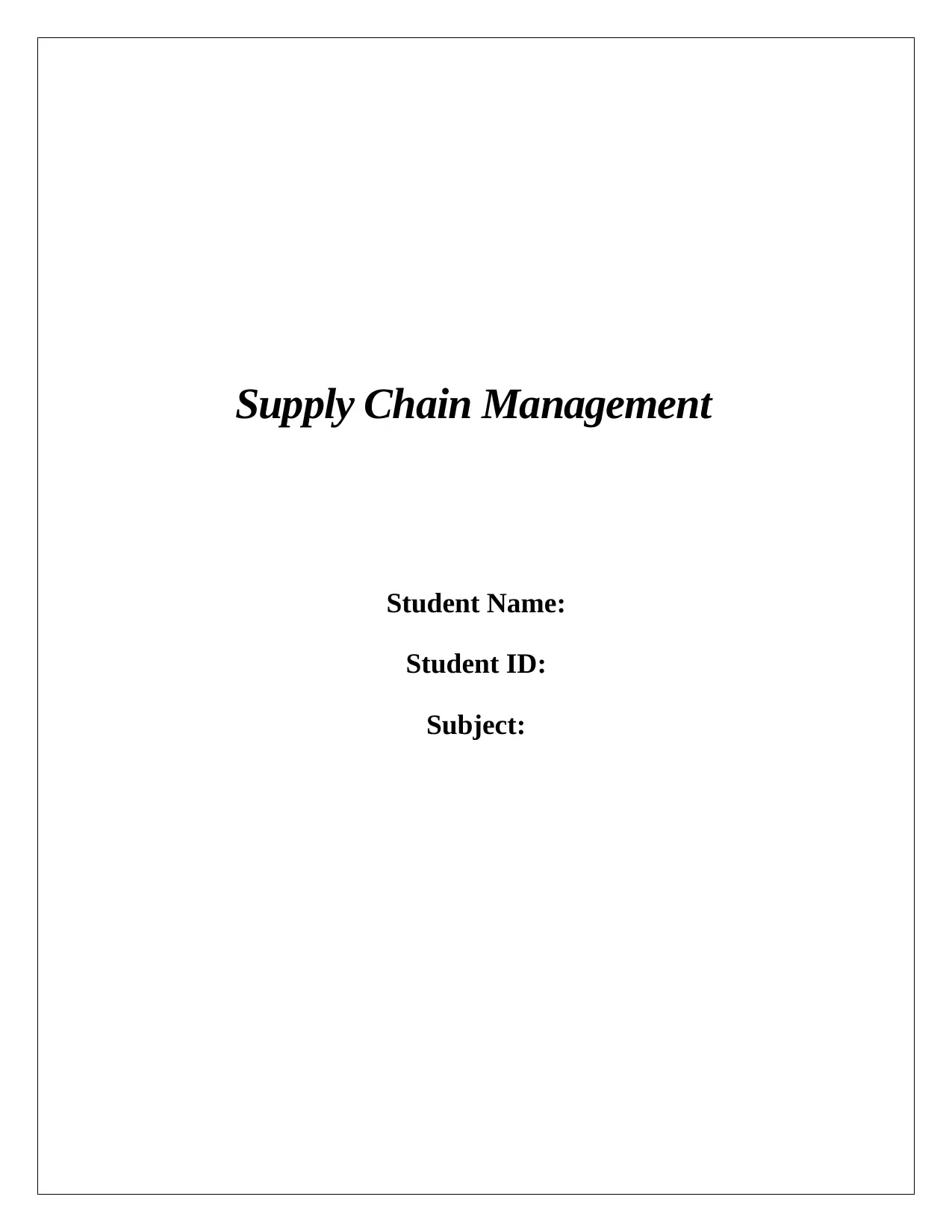
Supply Chain Management
Student Name:
Student ID:
Subject:
Student Name:
Student ID:
Subject:
Secure Best Marks with AI Grader
Need help grading? Try our AI Grader for instant feedback on your assignments.

1
Table of Contents
Introduction.................................................................................................................................................2
Methodology...............................................................................................................................................3
Principle 1: Segment customers based on the service needs of distinct groups and adapt the supply chain
to serve these segments profitably...............................................................................................................4
Principle 6: Develop a supply chain-wide technology strategy that supports multiple levels of decision
making and gives a clear view of the flow of products, services, and information......................................5
Other Principles...........................................................................................................................................6
Personal opinion..........................................................................................................................................6
Conclusion...................................................................................................................................................6
References...................................................................................................................................................9
Table of Contents
Introduction.................................................................................................................................................2
Methodology...............................................................................................................................................3
Principle 1: Segment customers based on the service needs of distinct groups and adapt the supply chain
to serve these segments profitably...............................................................................................................4
Principle 6: Develop a supply chain-wide technology strategy that supports multiple levels of decision
making and gives a clear view of the flow of products, services, and information......................................5
Other Principles...........................................................................................................................................6
Personal opinion..........................................................................................................................................6
Conclusion...................................................................................................................................................6
References...................................................................................................................................................9

2
Introduction
The article is entirely based on analyzing supply chain management based on seven
principles. The article was written by David Anderson, Donavon Favre and Frank Britt who are
considered to be the experts of Anderson consulting from the respected Logistics practice. In the
ten year history of supply chain management, it is considered to be the most requested article
that appeared in 1997 (Anderson, 1997). The article based on supply chain management is
determined to be a compelling and clear case that presents excellence in supply chain
management. The study provided with an understanding of the importance of supply chain
management for the managers within an organization. It helps the managers to gather
information on how to satisfy the needs of the customers effectively. It also presents the fact that
if the company is capable of fulfilling the demand of the customers than it helps the organization
to increase profitability and growth. It has been observed from the article that most of the
companies have achieved profitable growth by considering supply chain management as a
strategic variable. To enhance supply chain management, the managers within the organization
identifies two significant factors they are determining supply chain as a whole and gaining
tangible results. The first factor that considers supply chain as a whole includes managing the
flow of information, services, and products from their distributors to their customers. Whereas,
the second factor that is to gain tangible results focuses upon cost, utilization of asset and
revenue growth. The managers realized that rejecting a company's traditional view along with its
elements as distinct functional entities is an actual measure of success (Genovese et al., 2017). It
helps in executing the organizational activities effectively that generates significant value for
customers by maximizing profitability based on each chain of management.
The key aspects of this particular article are to provide with an analysis to enhance supply
chain management by more than 100 retailers, distributors, and manufacturers. It shows that by
making use of some of the principles of supply chain management, most of the companies have
gained profit. Whereas, few of the companies have failed by utilizing the techniques given in the
principles. Several themes have been shared by the organizations that have contributed to
profitable growth. The organizations have gained profitable growth due to broad efforts by
combining both tactical and strategic change (Martínez-Jurado and Moyano-Fuentes, 2014).
They present a holistic approach by observing supply chin from orchestrating an end to end
Introduction
The article is entirely based on analyzing supply chain management based on seven
principles. The article was written by David Anderson, Donavon Favre and Frank Britt who are
considered to be the experts of Anderson consulting from the respected Logistics practice. In the
ten year history of supply chain management, it is considered to be the most requested article
that appeared in 1997 (Anderson, 1997). The article based on supply chain management is
determined to be a compelling and clear case that presents excellence in supply chain
management. The study provided with an understanding of the importance of supply chain
management for the managers within an organization. It helps the managers to gather
information on how to satisfy the needs of the customers effectively. It also presents the fact that
if the company is capable of fulfilling the demand of the customers than it helps the organization
to increase profitability and growth. It has been observed from the article that most of the
companies have achieved profitable growth by considering supply chain management as a
strategic variable. To enhance supply chain management, the managers within the organization
identifies two significant factors they are determining supply chain as a whole and gaining
tangible results. The first factor that considers supply chain as a whole includes managing the
flow of information, services, and products from their distributors to their customers. Whereas,
the second factor that is to gain tangible results focuses upon cost, utilization of asset and
revenue growth. The managers realized that rejecting a company's traditional view along with its
elements as distinct functional entities is an actual measure of success (Genovese et al., 2017). It
helps in executing the organizational activities effectively that generates significant value for
customers by maximizing profitability based on each chain of management.
The key aspects of this particular article are to provide with an analysis to enhance supply
chain management by more than 100 retailers, distributors, and manufacturers. It shows that by
making use of some of the principles of supply chain management, most of the companies have
gained profit. Whereas, few of the companies have failed by utilizing the techniques given in the
principles. Several themes have been shared by the organizations that have contributed to
profitable growth. The organizations have gained profitable growth due to broad efforts by
combining both tactical and strategic change (Martínez-Jurado and Moyano-Fuentes, 2014).
They present a holistic approach by observing supply chin from orchestrating an end to end
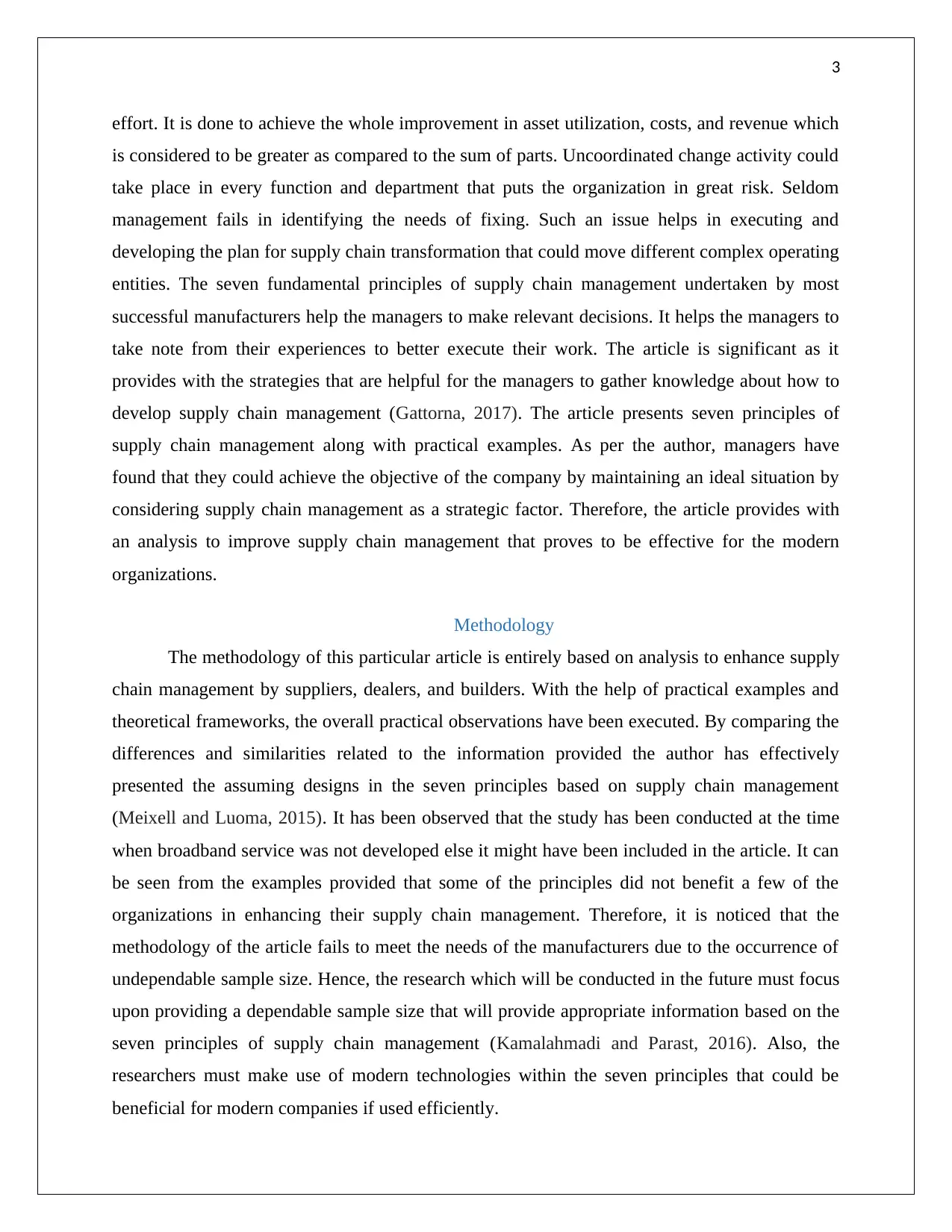
3
effort. It is done to achieve the whole improvement in asset utilization, costs, and revenue which
is considered to be greater as compared to the sum of parts. Uncoordinated change activity could
take place in every function and department that puts the organization in great risk. Seldom
management fails in identifying the needs of fixing. Such an issue helps in executing and
developing the plan for supply chain transformation that could move different complex operating
entities. The seven fundamental principles of supply chain management undertaken by most
successful manufacturers help the managers to make relevant decisions. It helps the managers to
take note from their experiences to better execute their work. The article is significant as it
provides with the strategies that are helpful for the managers to gather knowledge about how to
develop supply chain management (Gattorna, 2017). The article presents seven principles of
supply chain management along with practical examples. As per the author, managers have
found that they could achieve the objective of the company by maintaining an ideal situation by
considering supply chain management as a strategic factor. Therefore, the article provides with
an analysis to improve supply chain management that proves to be effective for the modern
organizations.
Methodology
The methodology of this particular article is entirely based on analysis to enhance supply
chain management by suppliers, dealers, and builders. With the help of practical examples and
theoretical frameworks, the overall practical observations have been executed. By comparing the
differences and similarities related to the information provided the author has effectively
presented the assuming designs in the seven principles based on supply chain management
(Meixell and Luoma, 2015). It has been observed that the study has been conducted at the time
when broadband service was not developed else it might have been included in the article. It can
be seen from the examples provided that some of the principles did not benefit a few of the
organizations in enhancing their supply chain management. Therefore, it is noticed that the
methodology of the article fails to meet the needs of the manufacturers due to the occurrence of
undependable sample size. Hence, the research which will be conducted in the future must focus
upon providing a dependable sample size that will provide appropriate information based on the
seven principles of supply chain management (Kamalahmadi and Parast, 2016). Also, the
researchers must make use of modern technologies within the seven principles that could be
beneficial for modern companies if used efficiently.
effort. It is done to achieve the whole improvement in asset utilization, costs, and revenue which
is considered to be greater as compared to the sum of parts. Uncoordinated change activity could
take place in every function and department that puts the organization in great risk. Seldom
management fails in identifying the needs of fixing. Such an issue helps in executing and
developing the plan for supply chain transformation that could move different complex operating
entities. The seven fundamental principles of supply chain management undertaken by most
successful manufacturers help the managers to make relevant decisions. It helps the managers to
take note from their experiences to better execute their work. The article is significant as it
provides with the strategies that are helpful for the managers to gather knowledge about how to
develop supply chain management (Gattorna, 2017). The article presents seven principles of
supply chain management along with practical examples. As per the author, managers have
found that they could achieve the objective of the company by maintaining an ideal situation by
considering supply chain management as a strategic factor. Therefore, the article provides with
an analysis to improve supply chain management that proves to be effective for the modern
organizations.
Methodology
The methodology of this particular article is entirely based on analysis to enhance supply
chain management by suppliers, dealers, and builders. With the help of practical examples and
theoretical frameworks, the overall practical observations have been executed. By comparing the
differences and similarities related to the information provided the author has effectively
presented the assuming designs in the seven principles based on supply chain management
(Meixell and Luoma, 2015). It has been observed that the study has been conducted at the time
when broadband service was not developed else it might have been included in the article. It can
be seen from the examples provided that some of the principles did not benefit a few of the
organizations in enhancing their supply chain management. Therefore, it is noticed that the
methodology of the article fails to meet the needs of the manufacturers due to the occurrence of
undependable sample size. Hence, the research which will be conducted in the future must focus
upon providing a dependable sample size that will provide appropriate information based on the
seven principles of supply chain management (Kamalahmadi and Parast, 2016). Also, the
researchers must make use of modern technologies within the seven principles that could be
beneficial for modern companies if used efficiently.
Secure Best Marks with AI Grader
Need help grading? Try our AI Grader for instant feedback on your assignments.
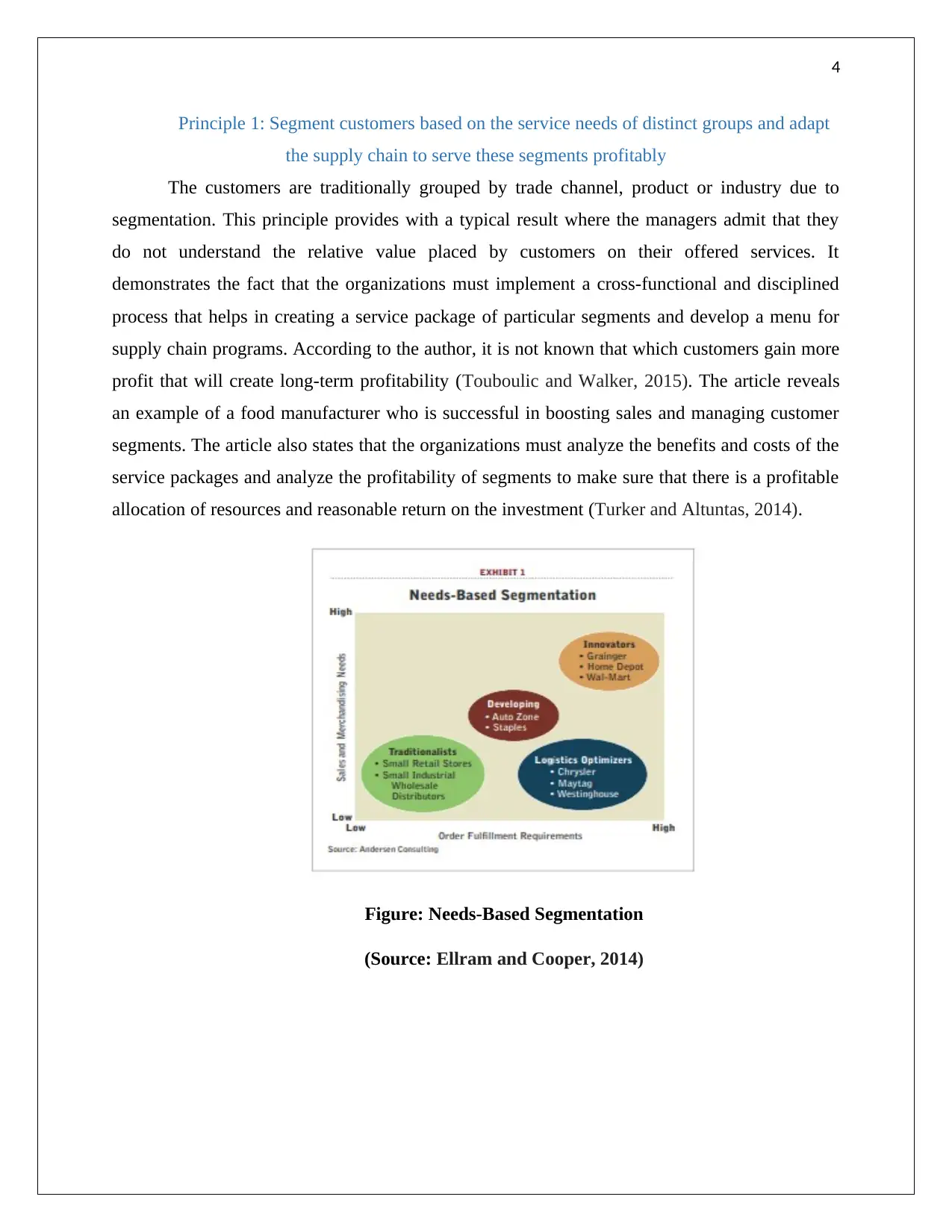
4
Principle 1: Segment customers based on the service needs of distinct groups and adapt
the supply chain to serve these segments profitably
The customers are traditionally grouped by trade channel, product or industry due to
segmentation. This principle provides with a typical result where the managers admit that they
do not understand the relative value placed by customers on their offered services. It
demonstrates the fact that the organizations must implement a cross-functional and disciplined
process that helps in creating a service package of particular segments and develop a menu for
supply chain programs. According to the author, it is not known that which customers gain more
profit that will create long-term profitability (Touboulic and Walker, 2015). The article reveals
an example of a food manufacturer who is successful in boosting sales and managing customer
segments. The article also states that the organizations must analyze the benefits and costs of the
service packages and analyze the profitability of segments to make sure that there is a profitable
allocation of resources and reasonable return on the investment (Turker and Altuntas, 2014).
Figure: Needs-Based Segmentation
(Source: Ellram and Cooper, 2014)
Principle 1: Segment customers based on the service needs of distinct groups and adapt
the supply chain to serve these segments profitably
The customers are traditionally grouped by trade channel, product or industry due to
segmentation. This principle provides with a typical result where the managers admit that they
do not understand the relative value placed by customers on their offered services. It
demonstrates the fact that the organizations must implement a cross-functional and disciplined
process that helps in creating a service package of particular segments and develop a menu for
supply chain programs. According to the author, it is not known that which customers gain more
profit that will create long-term profitability (Touboulic and Walker, 2015). The article reveals
an example of a food manufacturer who is successful in boosting sales and managing customer
segments. The article also states that the organizations must analyze the benefits and costs of the
service packages and analyze the profitability of segments to make sure that there is a profitable
allocation of resources and reasonable return on the investment (Turker and Altuntas, 2014).
Figure: Needs-Based Segmentation
(Source: Ellram and Cooper, 2014)
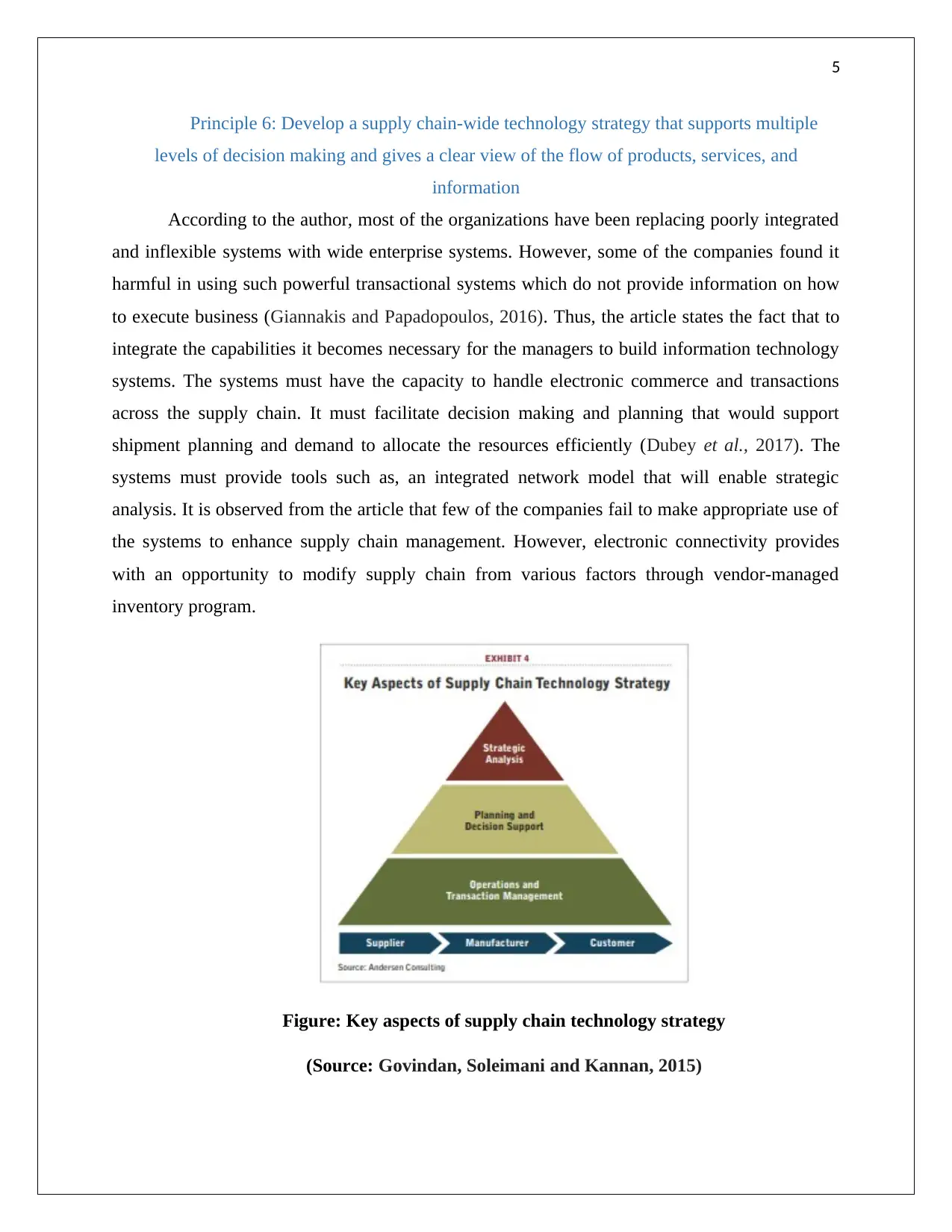
5
Principle 6: Develop a supply chain-wide technology strategy that supports multiple
levels of decision making and gives a clear view of the flow of products, services, and
information
According to the author, most of the organizations have been replacing poorly integrated
and inflexible systems with wide enterprise systems. However, some of the companies found it
harmful in using such powerful transactional systems which do not provide information on how
to execute business (Giannakis and Papadopoulos, 2016). Thus, the article states the fact that to
integrate the capabilities it becomes necessary for the managers to build information technology
systems. The systems must have the capacity to handle electronic commerce and transactions
across the supply chain. It must facilitate decision making and planning that would support
shipment planning and demand to allocate the resources efficiently (Dubey et al., 2017). The
systems must provide tools such as, an integrated network model that will enable strategic
analysis. It is observed from the article that few of the companies fail to make appropriate use of
the systems to enhance supply chain management. However, electronic connectivity provides
with an opportunity to modify supply chain from various factors through vendor-managed
inventory program.
Figure: Key aspects of supply chain technology strategy
(Source: Govindan, Soleimani and Kannan, 2015)
Principle 6: Develop a supply chain-wide technology strategy that supports multiple
levels of decision making and gives a clear view of the flow of products, services, and
information
According to the author, most of the organizations have been replacing poorly integrated
and inflexible systems with wide enterprise systems. However, some of the companies found it
harmful in using such powerful transactional systems which do not provide information on how
to execute business (Giannakis and Papadopoulos, 2016). Thus, the article states the fact that to
integrate the capabilities it becomes necessary for the managers to build information technology
systems. The systems must have the capacity to handle electronic commerce and transactions
across the supply chain. It must facilitate decision making and planning that would support
shipment planning and demand to allocate the resources efficiently (Dubey et al., 2017). The
systems must provide tools such as, an integrated network model that will enable strategic
analysis. It is observed from the article that few of the companies fail to make appropriate use of
the systems to enhance supply chain management. However, electronic connectivity provides
with an opportunity to modify supply chain from various factors through vendor-managed
inventory program.
Figure: Key aspects of supply chain technology strategy
(Source: Govindan, Soleimani and Kannan, 2015)
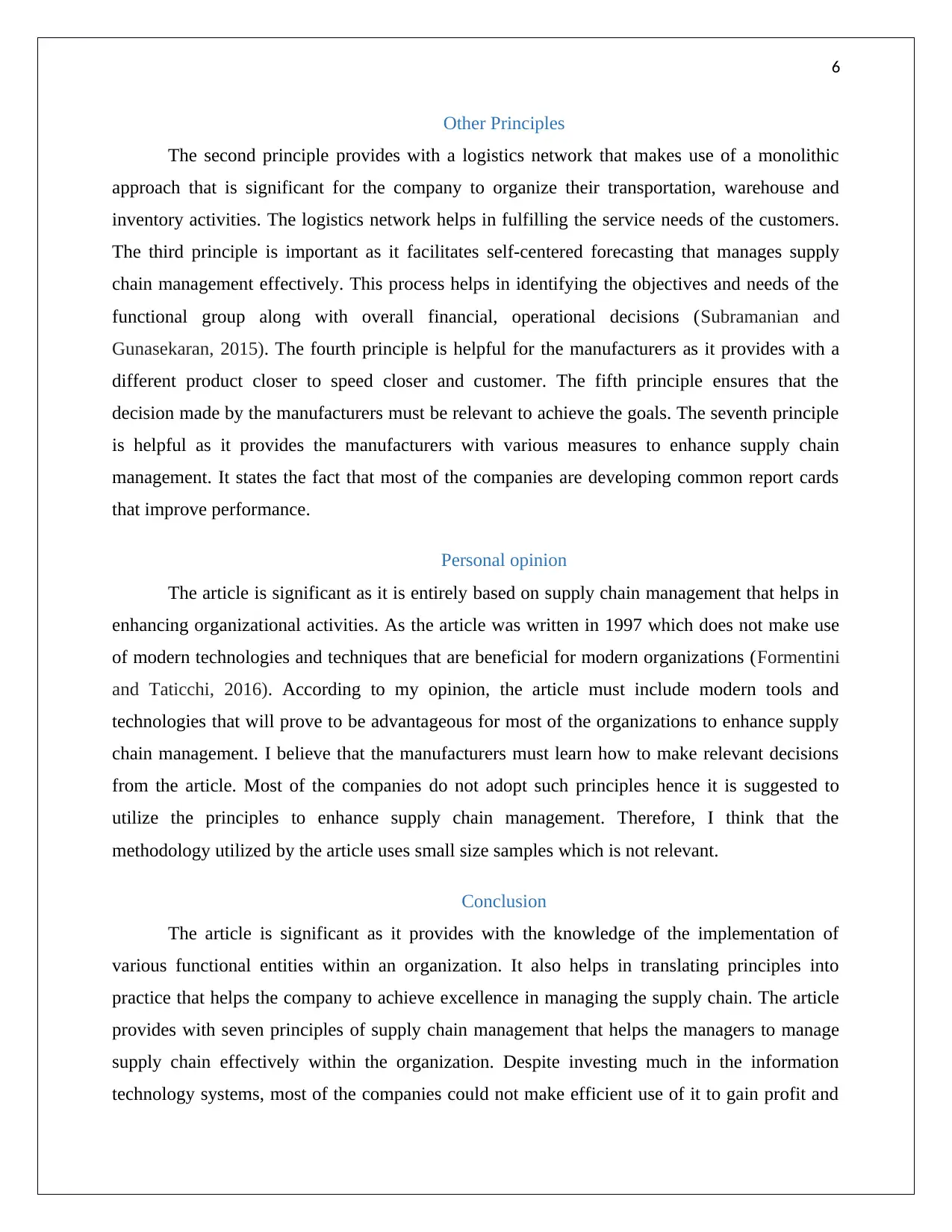
6
Other Principles
The second principle provides with a logistics network that makes use of a monolithic
approach that is significant for the company to organize their transportation, warehouse and
inventory activities. The logistics network helps in fulfilling the service needs of the customers.
The third principle is important as it facilitates self-centered forecasting that manages supply
chain management effectively. This process helps in identifying the objectives and needs of the
functional group along with overall financial, operational decisions (Subramanian and
Gunasekaran, 2015). The fourth principle is helpful for the manufacturers as it provides with a
different product closer to speed closer and customer. The fifth principle ensures that the
decision made by the manufacturers must be relevant to achieve the goals. The seventh principle
is helpful as it provides the manufacturers with various measures to enhance supply chain
management. It states the fact that most of the companies are developing common report cards
that improve performance.
Personal opinion
The article is significant as it is entirely based on supply chain management that helps in
enhancing organizational activities. As the article was written in 1997 which does not make use
of modern technologies and techniques that are beneficial for modern organizations (Formentini
and Taticchi, 2016). According to my opinion, the article must include modern tools and
technologies that will prove to be advantageous for most of the organizations to enhance supply
chain management. I believe that the manufacturers must learn how to make relevant decisions
from the article. Most of the companies do not adopt such principles hence it is suggested to
utilize the principles to enhance supply chain management. Therefore, I think that the
methodology utilized by the article uses small size samples which is not relevant.
Conclusion
The article is significant as it provides with the knowledge of the implementation of
various functional entities within an organization. It also helps in translating principles into
practice that helps the company to achieve excellence in managing the supply chain. The article
provides with seven principles of supply chain management that helps the managers to manage
supply chain effectively within the organization. Despite investing much in the information
technology systems, most of the companies could not make efficient use of it to gain profit and
Other Principles
The second principle provides with a logistics network that makes use of a monolithic
approach that is significant for the company to organize their transportation, warehouse and
inventory activities. The logistics network helps in fulfilling the service needs of the customers.
The third principle is important as it facilitates self-centered forecasting that manages supply
chain management effectively. This process helps in identifying the objectives and needs of the
functional group along with overall financial, operational decisions (Subramanian and
Gunasekaran, 2015). The fourth principle is helpful for the manufacturers as it provides with a
different product closer to speed closer and customer. The fifth principle ensures that the
decision made by the manufacturers must be relevant to achieve the goals. The seventh principle
is helpful as it provides the manufacturers with various measures to enhance supply chain
management. It states the fact that most of the companies are developing common report cards
that improve performance.
Personal opinion
The article is significant as it is entirely based on supply chain management that helps in
enhancing organizational activities. As the article was written in 1997 which does not make use
of modern technologies and techniques that are beneficial for modern organizations (Formentini
and Taticchi, 2016). According to my opinion, the article must include modern tools and
technologies that will prove to be advantageous for most of the organizations to enhance supply
chain management. I believe that the manufacturers must learn how to make relevant decisions
from the article. Most of the companies do not adopt such principles hence it is suggested to
utilize the principles to enhance supply chain management. Therefore, I think that the
methodology utilized by the article uses small size samples which is not relevant.
Conclusion
The article is significant as it provides with the knowledge of the implementation of
various functional entities within an organization. It also helps in translating principles into
practice that helps the company to achieve excellence in managing the supply chain. The article
provides with seven principles of supply chain management that helps the managers to manage
supply chain effectively within the organization. Despite investing much in the information
technology systems, most of the companies could not make efficient use of it to gain profit and
Paraphrase This Document
Need a fresh take? Get an instant paraphrase of this document with our AI Paraphraser
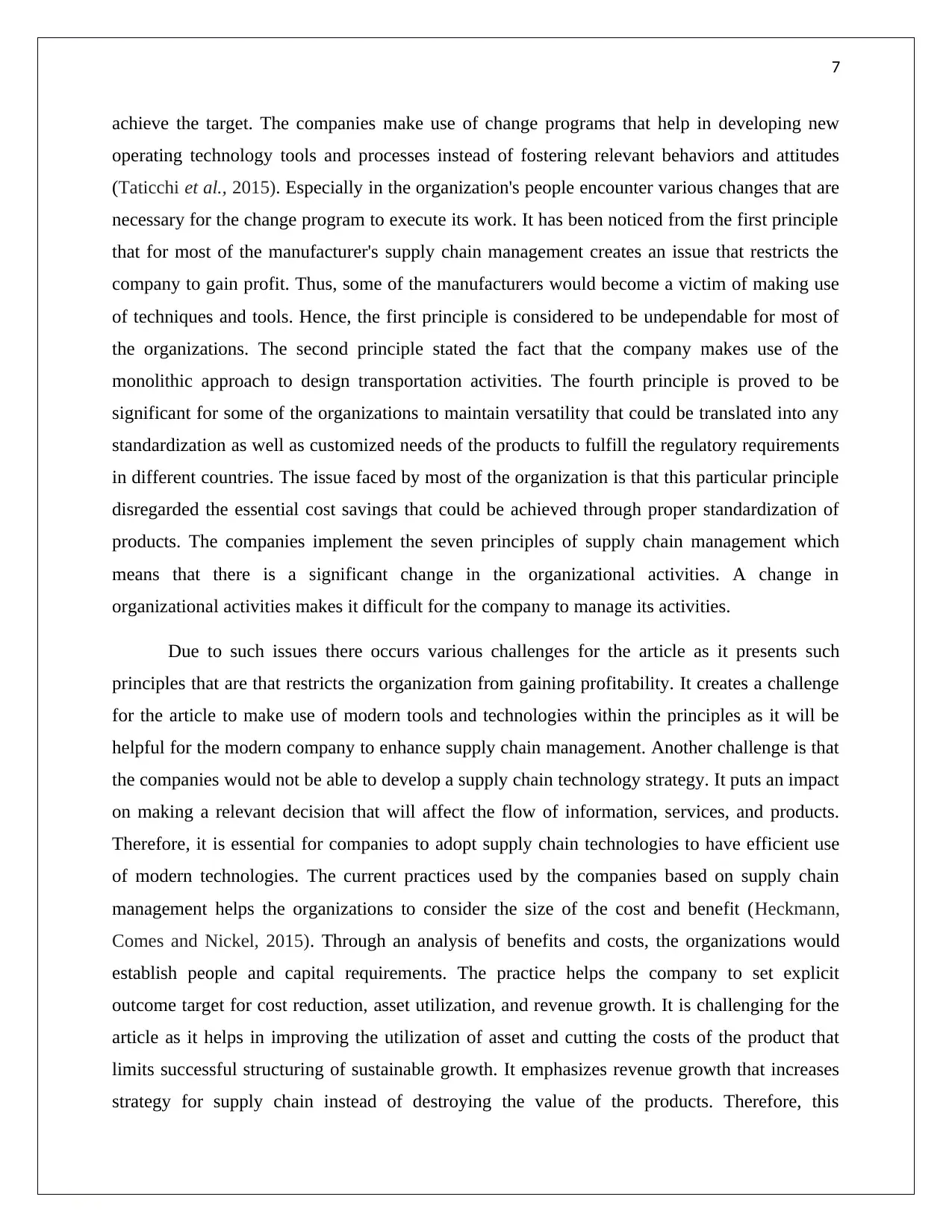
7
achieve the target. The companies make use of change programs that help in developing new
operating technology tools and processes instead of fostering relevant behaviors and attitudes
(Taticchi et al., 2015). Especially in the organization's people encounter various changes that are
necessary for the change program to execute its work. It has been noticed from the first principle
that for most of the manufacturer's supply chain management creates an issue that restricts the
company to gain profit. Thus, some of the manufacturers would become a victim of making use
of techniques and tools. Hence, the first principle is considered to be undependable for most of
the organizations. The second principle stated the fact that the company makes use of the
monolithic approach to design transportation activities. The fourth principle is proved to be
significant for some of the organizations to maintain versatility that could be translated into any
standardization as well as customized needs of the products to fulfill the regulatory requirements
in different countries. The issue faced by most of the organization is that this particular principle
disregarded the essential cost savings that could be achieved through proper standardization of
products. The companies implement the seven principles of supply chain management which
means that there is a significant change in the organizational activities. A change in
organizational activities makes it difficult for the company to manage its activities.
Due to such issues there occurs various challenges for the article as it presents such
principles that are that restricts the organization from gaining profitability. It creates a challenge
for the article to make use of modern tools and technologies within the principles as it will be
helpful for the modern company to enhance supply chain management. Another challenge is that
the companies would not be able to develop a supply chain technology strategy. It puts an impact
on making a relevant decision that will affect the flow of information, services, and products.
Therefore, it is essential for companies to adopt supply chain technologies to have efficient use
of modern technologies. The current practices used by the companies based on supply chain
management helps the organizations to consider the size of the cost and benefit (Heckmann,
Comes and Nickel, 2015). Through an analysis of benefits and costs, the organizations would
establish people and capital requirements. The practice helps the company to set explicit
outcome target for cost reduction, asset utilization, and revenue growth. It is challenging for the
article as it helps in improving the utilization of asset and cutting the costs of the product that
limits successful structuring of sustainable growth. It emphasizes revenue growth that increases
strategy for supply chain instead of destroying the value of the products. Therefore, this
achieve the target. The companies make use of change programs that help in developing new
operating technology tools and processes instead of fostering relevant behaviors and attitudes
(Taticchi et al., 2015). Especially in the organization's people encounter various changes that are
necessary for the change program to execute its work. It has been noticed from the first principle
that for most of the manufacturer's supply chain management creates an issue that restricts the
company to gain profit. Thus, some of the manufacturers would become a victim of making use
of techniques and tools. Hence, the first principle is considered to be undependable for most of
the organizations. The second principle stated the fact that the company makes use of the
monolithic approach to design transportation activities. The fourth principle is proved to be
significant for some of the organizations to maintain versatility that could be translated into any
standardization as well as customized needs of the products to fulfill the regulatory requirements
in different countries. The issue faced by most of the organization is that this particular principle
disregarded the essential cost savings that could be achieved through proper standardization of
products. The companies implement the seven principles of supply chain management which
means that there is a significant change in the organizational activities. A change in
organizational activities makes it difficult for the company to manage its activities.
Due to such issues there occurs various challenges for the article as it presents such
principles that are that restricts the organization from gaining profitability. It creates a challenge
for the article to make use of modern tools and technologies within the principles as it will be
helpful for the modern company to enhance supply chain management. Another challenge is that
the companies would not be able to develop a supply chain technology strategy. It puts an impact
on making a relevant decision that will affect the flow of information, services, and products.
Therefore, it is essential for companies to adopt supply chain technologies to have efficient use
of modern technologies. The current practices used by the companies based on supply chain
management helps the organizations to consider the size of the cost and benefit (Heckmann,
Comes and Nickel, 2015). Through an analysis of benefits and costs, the organizations would
establish people and capital requirements. The practice helps the company to set explicit
outcome target for cost reduction, asset utilization, and revenue growth. It is challenging for the
article as it helps in improving the utilization of asset and cutting the costs of the product that
limits successful structuring of sustainable growth. It emphasizes revenue growth that increases
strategy for supply chain instead of destroying the value of the products. Therefore, this

8
particular plan helps in realizing the benefits that focused upon the management of the supply
chain.
particular plan helps in realizing the benefits that focused upon the management of the supply
chain.
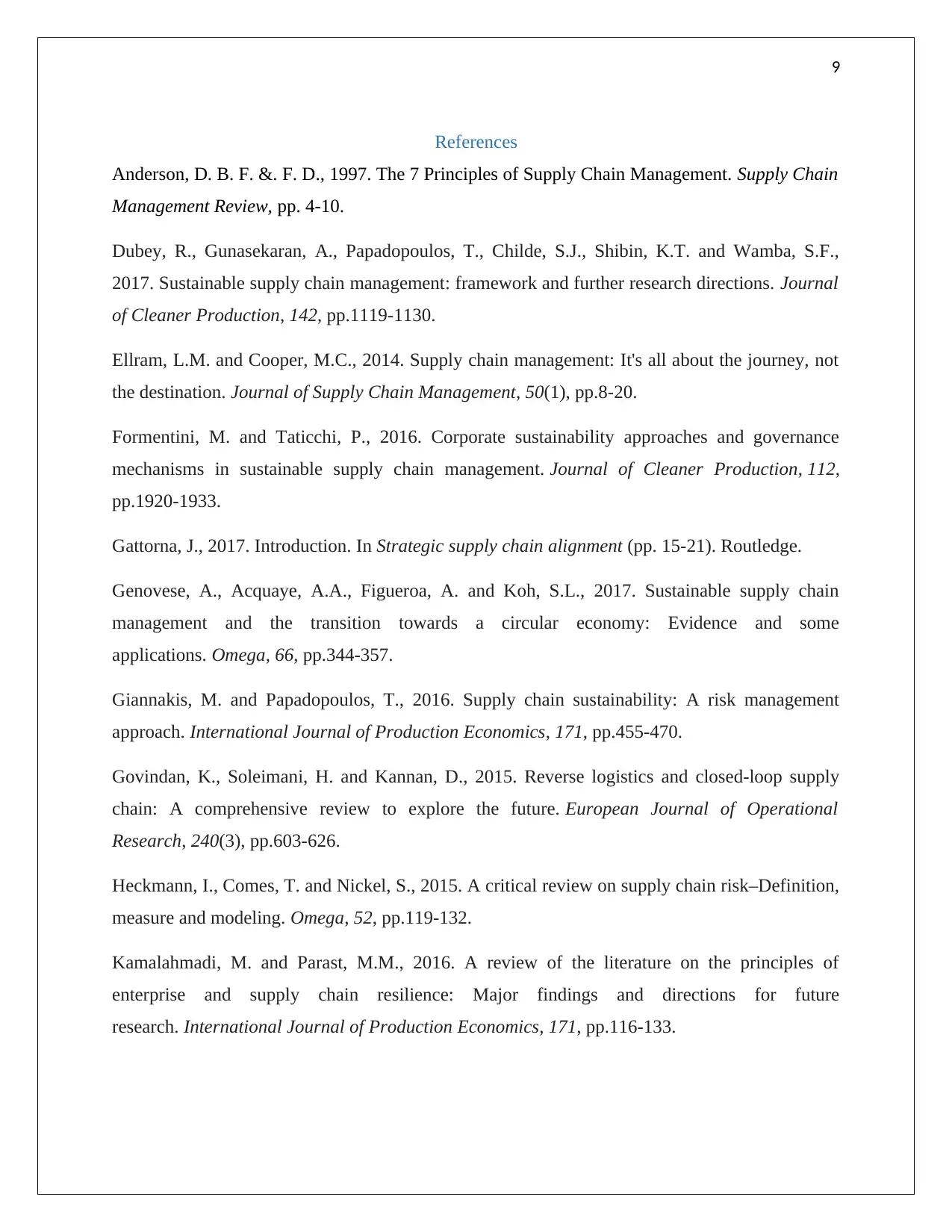
9
References
Anderson, D. B. F. &. F. D., 1997. The 7 Principles of Supply Chain Management. Supply Chain
Management Review, pp. 4-10.
Dubey, R., Gunasekaran, A., Papadopoulos, T., Childe, S.J., Shibin, K.T. and Wamba, S.F.,
2017. Sustainable supply chain management: framework and further research directions. Journal
of Cleaner Production, 142, pp.1119-1130.
Ellram, L.M. and Cooper, M.C., 2014. Supply chain management: It's all about the journey, not
the destination. Journal of Supply Chain Management, 50(1), pp.8-20.
Formentini, M. and Taticchi, P., 2016. Corporate sustainability approaches and governance
mechanisms in sustainable supply chain management. Journal of Cleaner Production, 112,
pp.1920-1933.
Gattorna, J., 2017. Introduction. In Strategic supply chain alignment (pp. 15-21). Routledge.
Genovese, A., Acquaye, A.A., Figueroa, A. and Koh, S.L., 2017. Sustainable supply chain
management and the transition towards a circular economy: Evidence and some
applications. Omega, 66, pp.344-357.
Giannakis, M. and Papadopoulos, T., 2016. Supply chain sustainability: A risk management
approach. International Journal of Production Economics, 171, pp.455-470.
Govindan, K., Soleimani, H. and Kannan, D., 2015. Reverse logistics and closed-loop supply
chain: A comprehensive review to explore the future. European Journal of Operational
Research, 240(3), pp.603-626.
Heckmann, I., Comes, T. and Nickel, S., 2015. A critical review on supply chain risk–Definition,
measure and modeling. Omega, 52, pp.119-132.
Kamalahmadi, M. and Parast, M.M., 2016. A review of the literature on the principles of
enterprise and supply chain resilience: Major findings and directions for future
research. International Journal of Production Economics, 171, pp.116-133.
References
Anderson, D. B. F. &. F. D., 1997. The 7 Principles of Supply Chain Management. Supply Chain
Management Review, pp. 4-10.
Dubey, R., Gunasekaran, A., Papadopoulos, T., Childe, S.J., Shibin, K.T. and Wamba, S.F.,
2017. Sustainable supply chain management: framework and further research directions. Journal
of Cleaner Production, 142, pp.1119-1130.
Ellram, L.M. and Cooper, M.C., 2014. Supply chain management: It's all about the journey, not
the destination. Journal of Supply Chain Management, 50(1), pp.8-20.
Formentini, M. and Taticchi, P., 2016. Corporate sustainability approaches and governance
mechanisms in sustainable supply chain management. Journal of Cleaner Production, 112,
pp.1920-1933.
Gattorna, J., 2017. Introduction. In Strategic supply chain alignment (pp. 15-21). Routledge.
Genovese, A., Acquaye, A.A., Figueroa, A. and Koh, S.L., 2017. Sustainable supply chain
management and the transition towards a circular economy: Evidence and some
applications. Omega, 66, pp.344-357.
Giannakis, M. and Papadopoulos, T., 2016. Supply chain sustainability: A risk management
approach. International Journal of Production Economics, 171, pp.455-470.
Govindan, K., Soleimani, H. and Kannan, D., 2015. Reverse logistics and closed-loop supply
chain: A comprehensive review to explore the future. European Journal of Operational
Research, 240(3), pp.603-626.
Heckmann, I., Comes, T. and Nickel, S., 2015. A critical review on supply chain risk–Definition,
measure and modeling. Omega, 52, pp.119-132.
Kamalahmadi, M. and Parast, M.M., 2016. A review of the literature on the principles of
enterprise and supply chain resilience: Major findings and directions for future
research. International Journal of Production Economics, 171, pp.116-133.
Secure Best Marks with AI Grader
Need help grading? Try our AI Grader for instant feedback on your assignments.
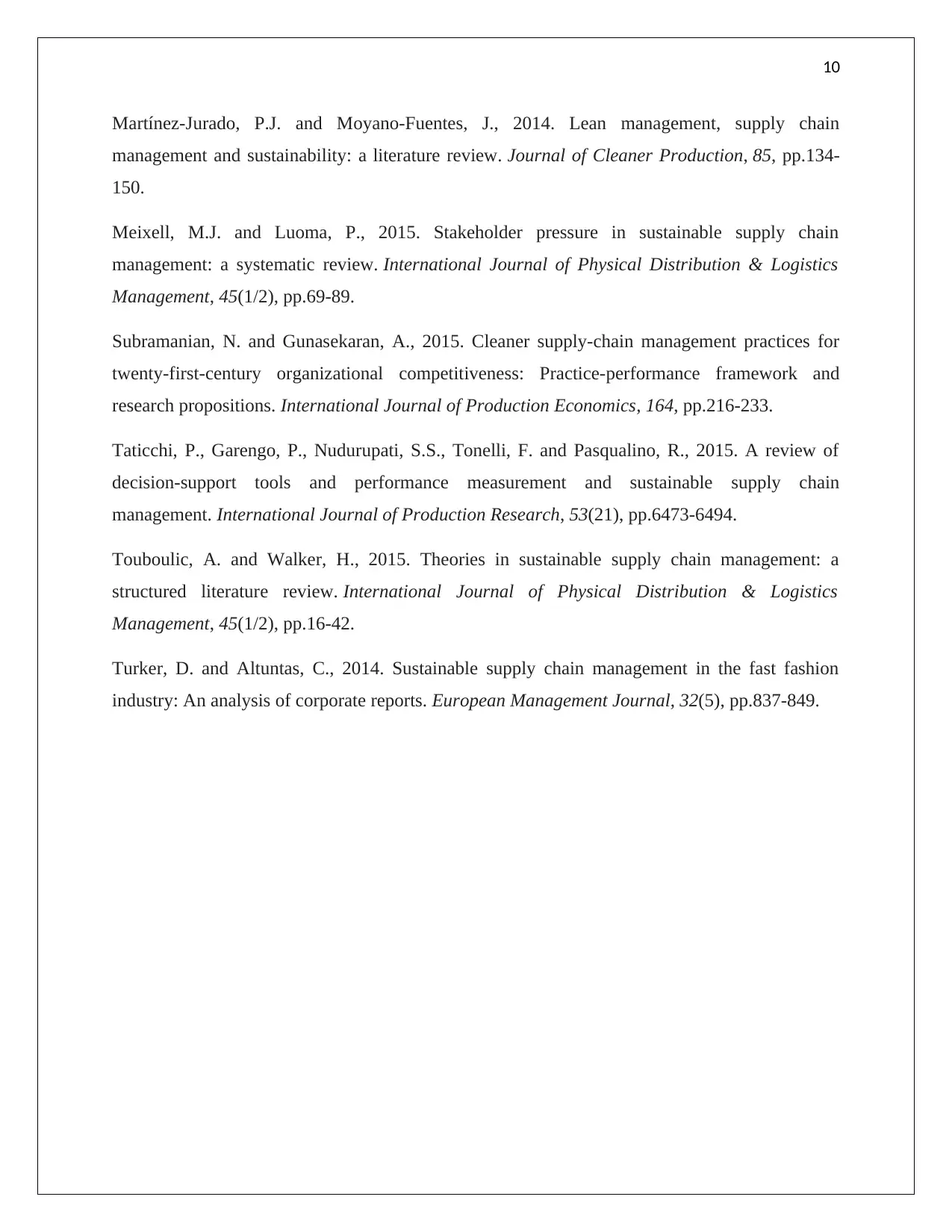
10
Martínez-Jurado, P.J. and Moyano-Fuentes, J., 2014. Lean management, supply chain
management and sustainability: a literature review. Journal of Cleaner Production, 85, pp.134-
150.
Meixell, M.J. and Luoma, P., 2015. Stakeholder pressure in sustainable supply chain
management: a systematic review. International Journal of Physical Distribution & Logistics
Management, 45(1/2), pp.69-89.
Subramanian, N. and Gunasekaran, A., 2015. Cleaner supply-chain management practices for
twenty-first-century organizational competitiveness: Practice-performance framework and
research propositions. International Journal of Production Economics, 164, pp.216-233.
Taticchi, P., Garengo, P., Nudurupati, S.S., Tonelli, F. and Pasqualino, R., 2015. A review of
decision-support tools and performance measurement and sustainable supply chain
management. International Journal of Production Research, 53(21), pp.6473-6494.
Touboulic, A. and Walker, H., 2015. Theories in sustainable supply chain management: a
structured literature review. International Journal of Physical Distribution & Logistics
Management, 45(1/2), pp.16-42.
Turker, D. and Altuntas, C., 2014. Sustainable supply chain management in the fast fashion
industry: An analysis of corporate reports. European Management Journal, 32(5), pp.837-849.
Martínez-Jurado, P.J. and Moyano-Fuentes, J., 2014. Lean management, supply chain
management and sustainability: a literature review. Journal of Cleaner Production, 85, pp.134-
150.
Meixell, M.J. and Luoma, P., 2015. Stakeholder pressure in sustainable supply chain
management: a systematic review. International Journal of Physical Distribution & Logistics
Management, 45(1/2), pp.69-89.
Subramanian, N. and Gunasekaran, A., 2015. Cleaner supply-chain management practices for
twenty-first-century organizational competitiveness: Practice-performance framework and
research propositions. International Journal of Production Economics, 164, pp.216-233.
Taticchi, P., Garengo, P., Nudurupati, S.S., Tonelli, F. and Pasqualino, R., 2015. A review of
decision-support tools and performance measurement and sustainable supply chain
management. International Journal of Production Research, 53(21), pp.6473-6494.
Touboulic, A. and Walker, H., 2015. Theories in sustainable supply chain management: a
structured literature review. International Journal of Physical Distribution & Logistics
Management, 45(1/2), pp.16-42.
Turker, D. and Altuntas, C., 2014. Sustainable supply chain management in the fast fashion
industry: An analysis of corporate reports. European Management Journal, 32(5), pp.837-849.
1 out of 11
Related Documents
Your All-in-One AI-Powered Toolkit for Academic Success.
+13062052269
info@desklib.com
Available 24*7 on WhatsApp / Email
![[object Object]](/_next/static/media/star-bottom.7253800d.svg)
Unlock your academic potential
© 2024 | Zucol Services PVT LTD | All rights reserved.





